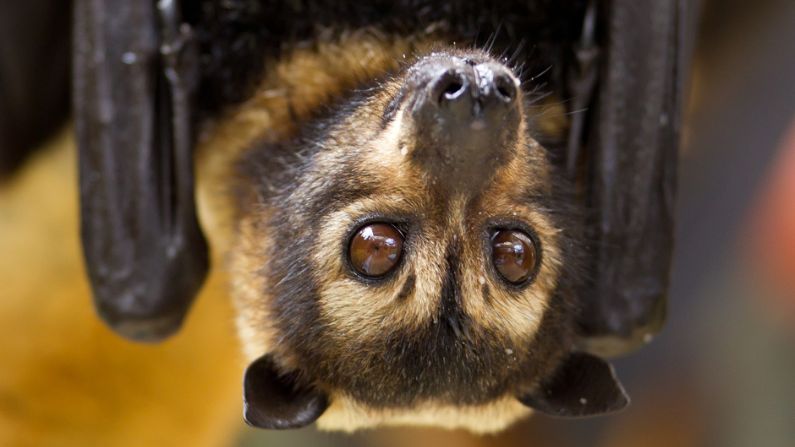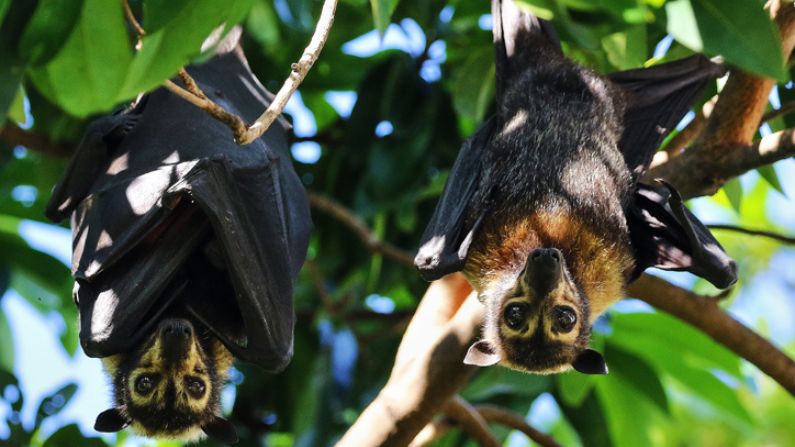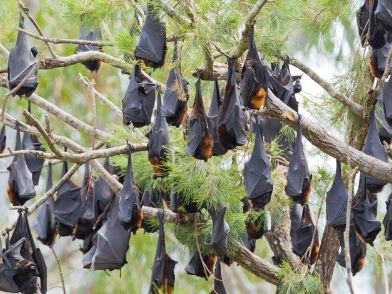Spectacled flying-fox
© Bruce Thomson
Spectacled flying-foxes were first described in 1850 by Gould from a specimen collected on Fitzroy Island. They are important seed dispersers and pollinators of rainforest flora. Spectacled flying-foxes have the smallest known distribution and population of the four Australian mainland Pteropus flying-foxes.
Quick facts
COMMON NAME:
Spectacled flying-fox
SCIENTIFIC NAME:
Pteropus conspicillatus
FAMILY:
Pteropodidae
Spectacled fruit-bat
QLD CONSERVATION STATUS:
Endangered
NATIONAL CONSERVATION STATUS:
Endangered
How we help flying-foxes
Every summer for more than 30 years, Wildlife Queensland’s Batty Boat Cruises have introduced thousands of people to the fascinating world of flying-foxes. This successful education initiative provides an opportunity for everyone to see flying-foxes in their natural habitat and learn why they are so important to our environment. Proceeds from the cruises fund bat conservation and support bat carers within Queensland.
 © Bruce Thomson
© Bruce Thomson
Did you know?
Persecution by fruit-growers using electric grids to kill feeding flying-foxes in Far North Queensland was a major threat to the species in the early part of the 21st century. A series of court cases by conservationists demonstrated that the very existence of the species, and consequently the World Heritage Area Wet Tropics forests, was at risk. The cases set a legal precedent and resulted in electric grids being banned in Queensland.
 © Paul Berridge
© Paul Berridge
Threats to little spectacled flying-foxes
- Habitat destruction through the large-scale clearing of coastal and upland habitats for sugar, grazing and urban development.
- Mortality due to paralysis tick (Ixodes holocyclus).
- Disturbance at maternity colonies.
- Death of unknown numbers on barbed wire fences and powerlines.
- Predators — dogs and cats.
Home range
- Only travel 20-30 km from camp to feed.
Distribution
- Coastal Queensland from Tully to the tip of Cape York and islands in Torres Strait.
- Spectacled flying-foxes are generally found in or around rainforests and sometimes in mangroves associated with black flying-foxes.
Description
- Spectacled flying-foxes have distinctive straw-coloured fur around the eyes which gives them their name.
- Eye rings can sometimes be indistinct and they will look similar to black flying-foxes.
- Pale fur on shoulders can vary between individuals.
- Average weight 500-1000 g.
- Head-body length 220-240 mm.
Habitat
- Tall rainforests, gallery forest, mangroves or paperbark forests.
Ecology
Life history and behaviour
- Little is known about the life span of spectacled flying-foxes in the wild but can live in captivity for 17 years.
- Usually, roost in single-species camps.
- Territorial and aggressive at rich food resources.
- Forage only during the night.
Breeding
- Mating is common throughout the first half of the year but conception only in March-May, single young born October-December.
- Mothers give birth upside down and carry the young for 3-4 weeks.
- Older young stay at the camp until they start to fly.
Food
- Specialist fruit eater that feeds mostly on rainforest fruits, some eucalyptus nectar and pollen.
- Disperses seeds of at least 26 species of rainforest canopy trees.
More information
Publications & papers
- Hall, L. & Richards, R. (2000). Flying-foxes and fruit and blossom bats of Australia. Australian Natural History Series. UNSW Press.
- Menkhorst, P. & Knight, F. (2004) A Field Guide to the Mammals of Australia. Oxford University Press.



